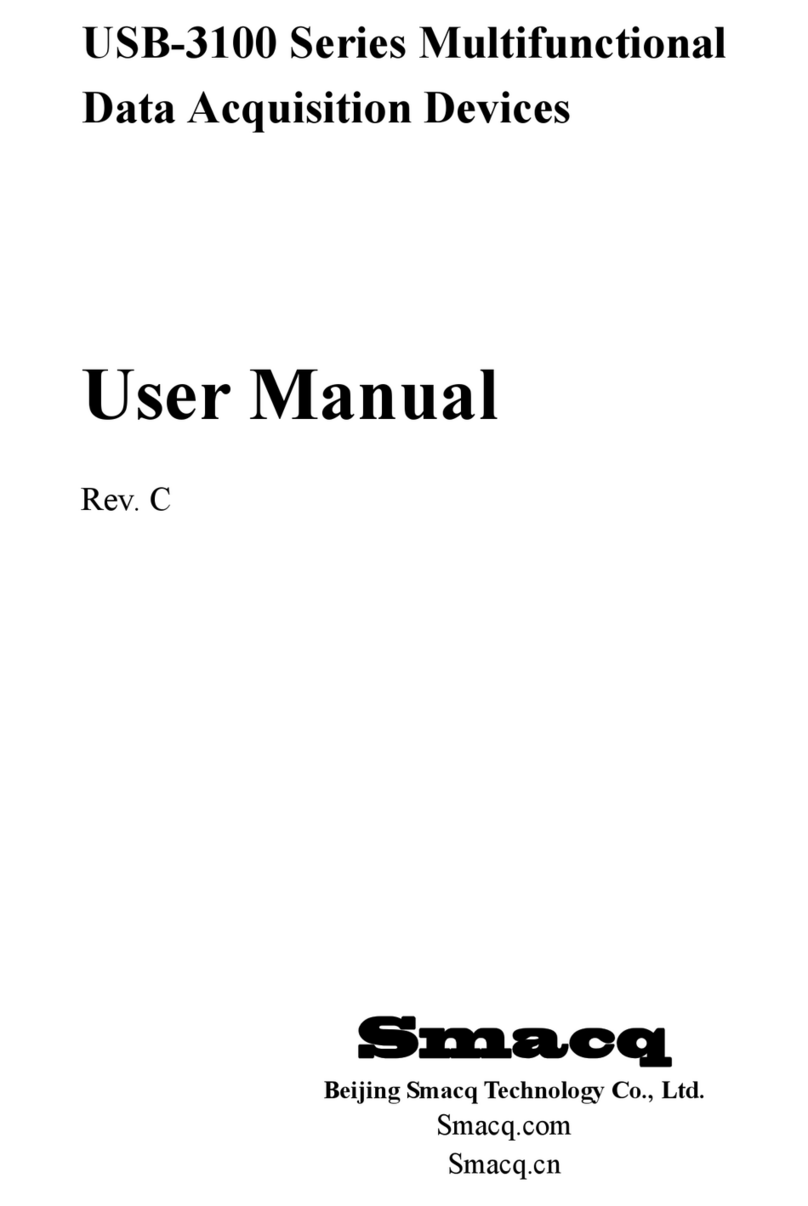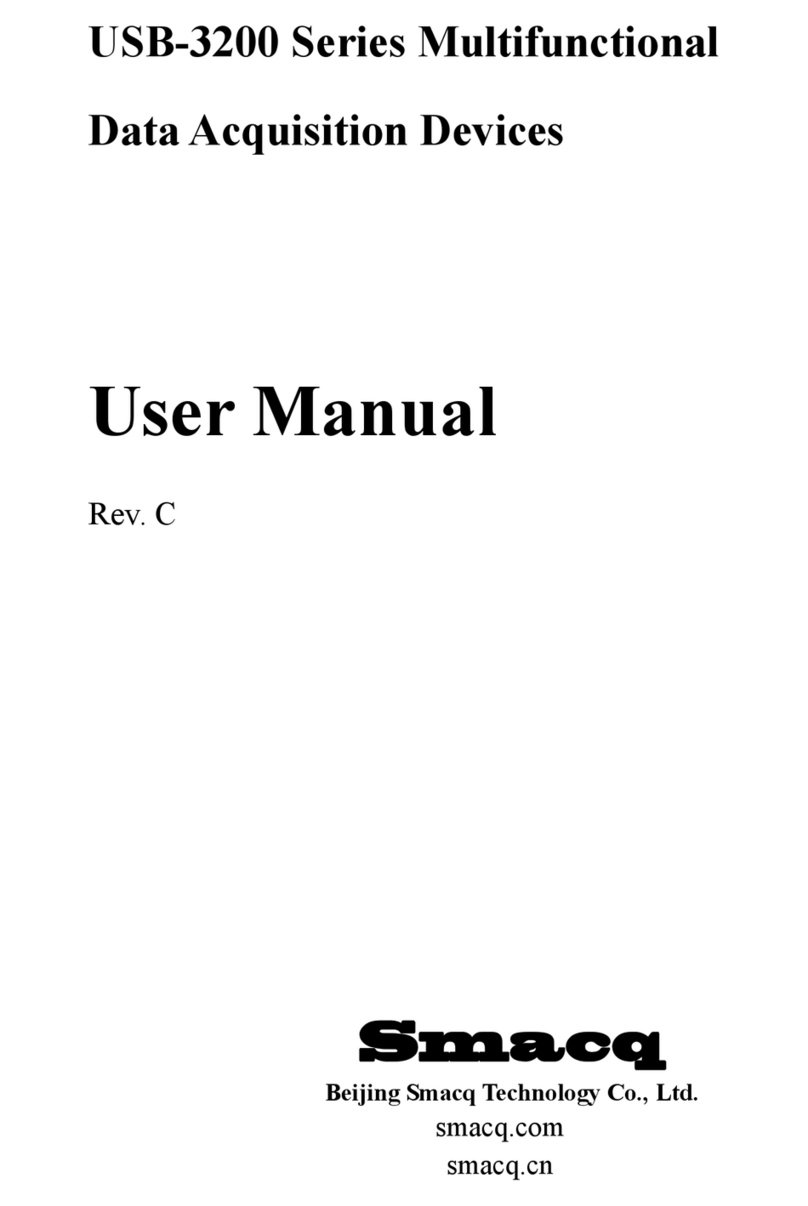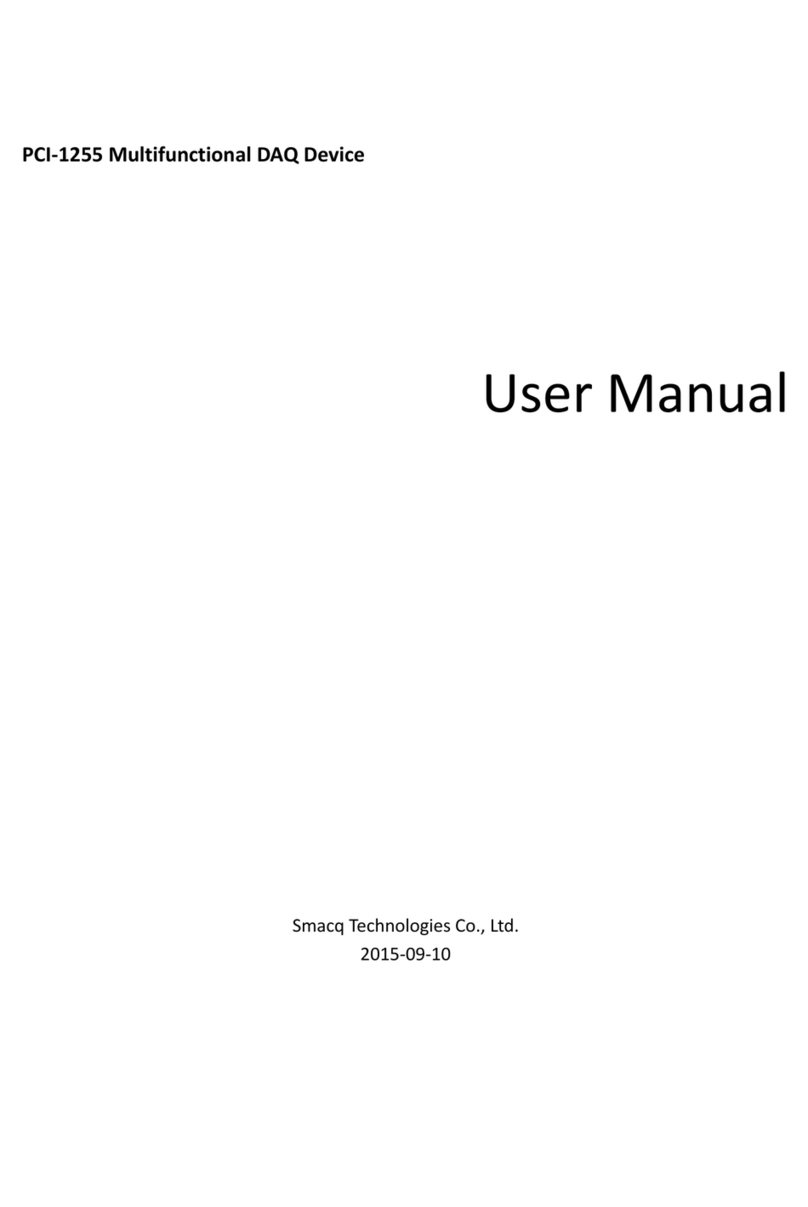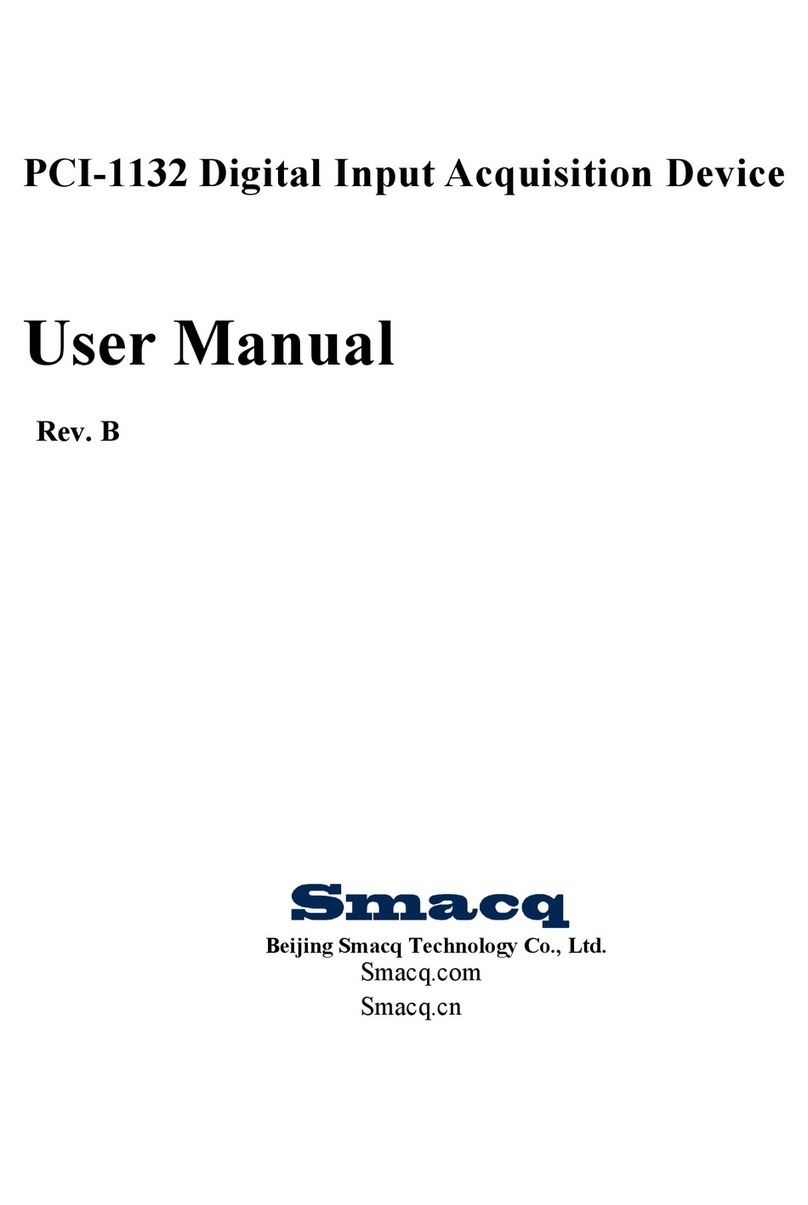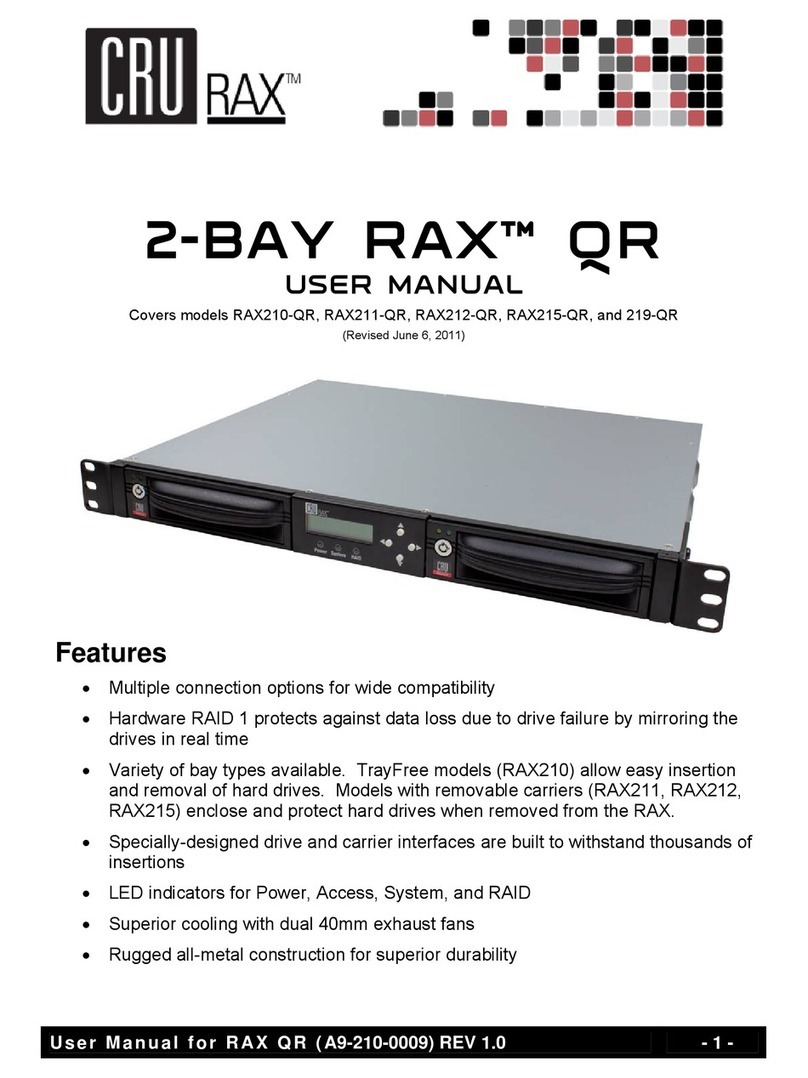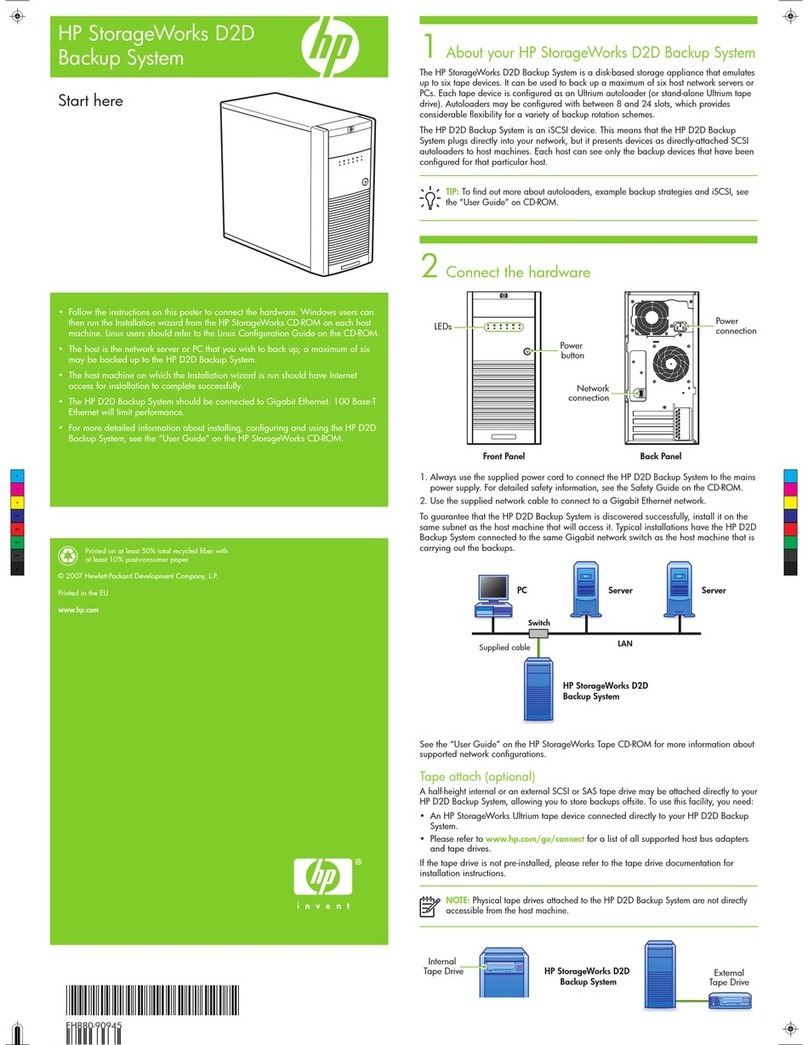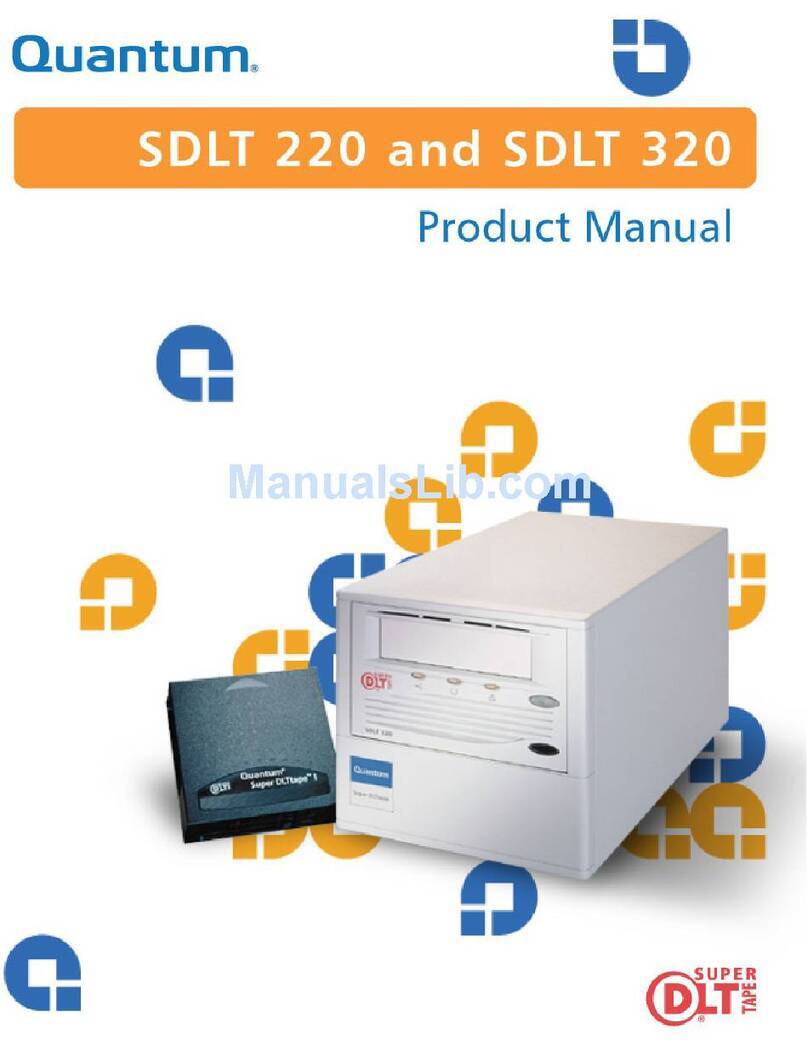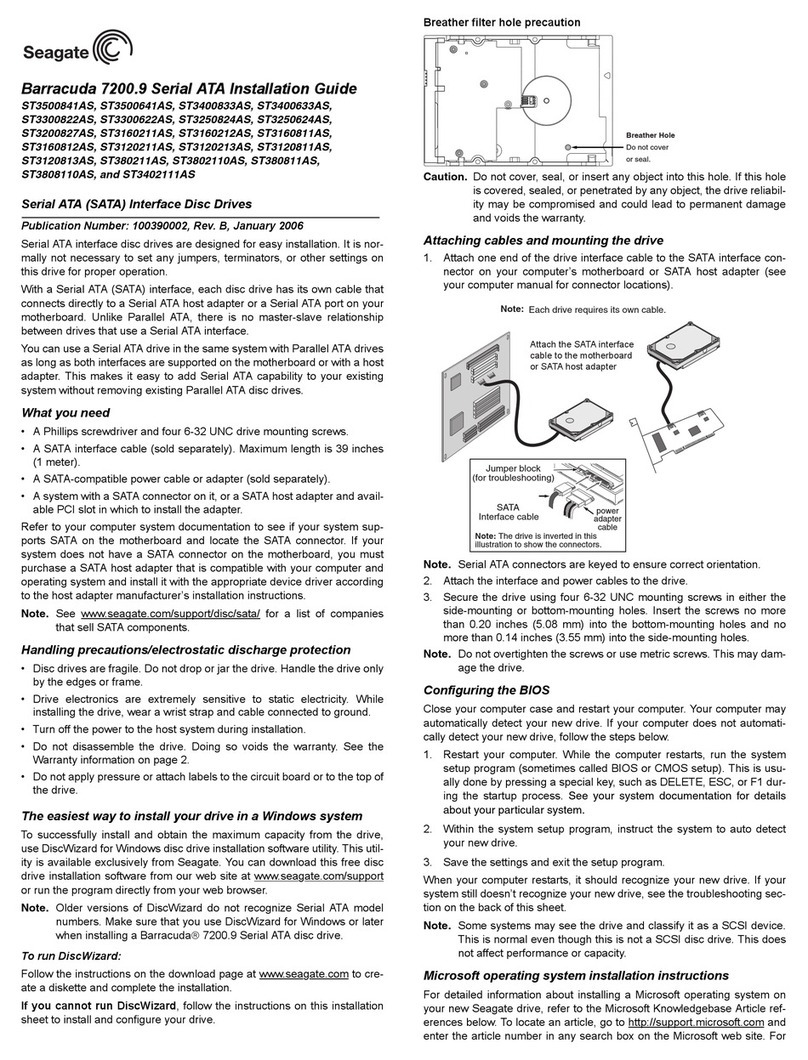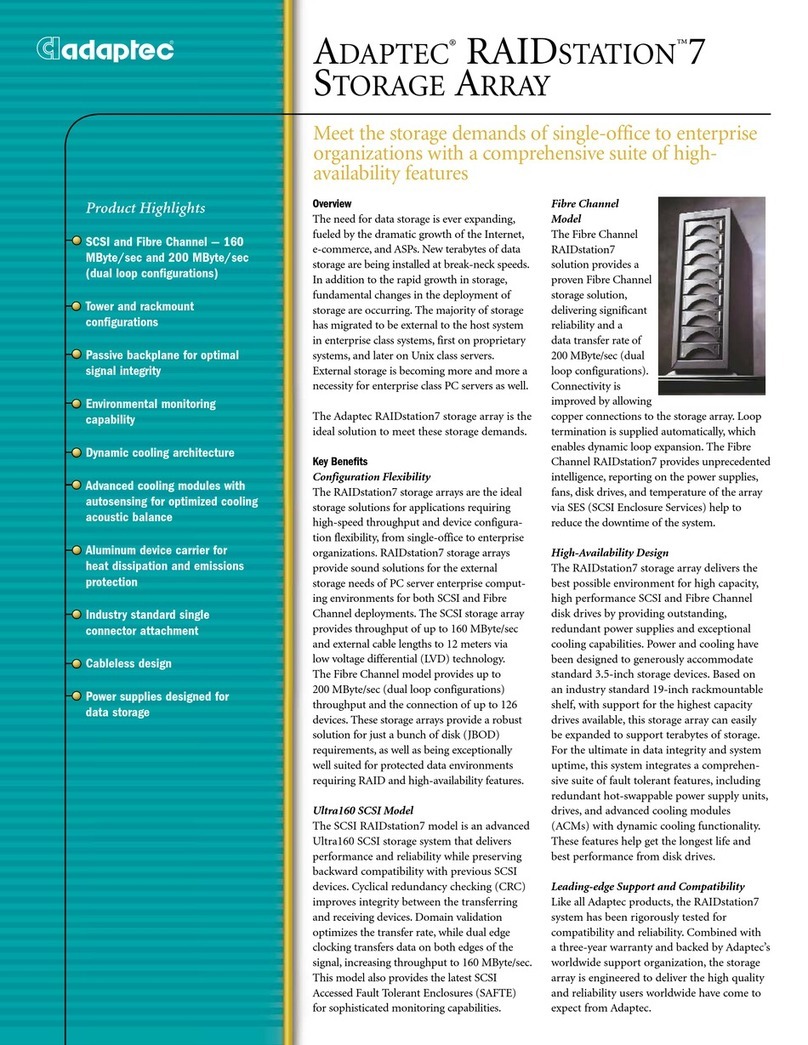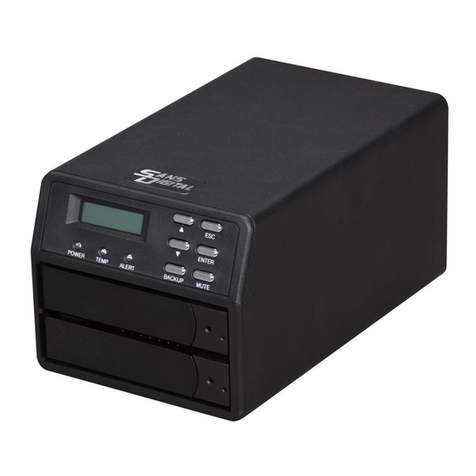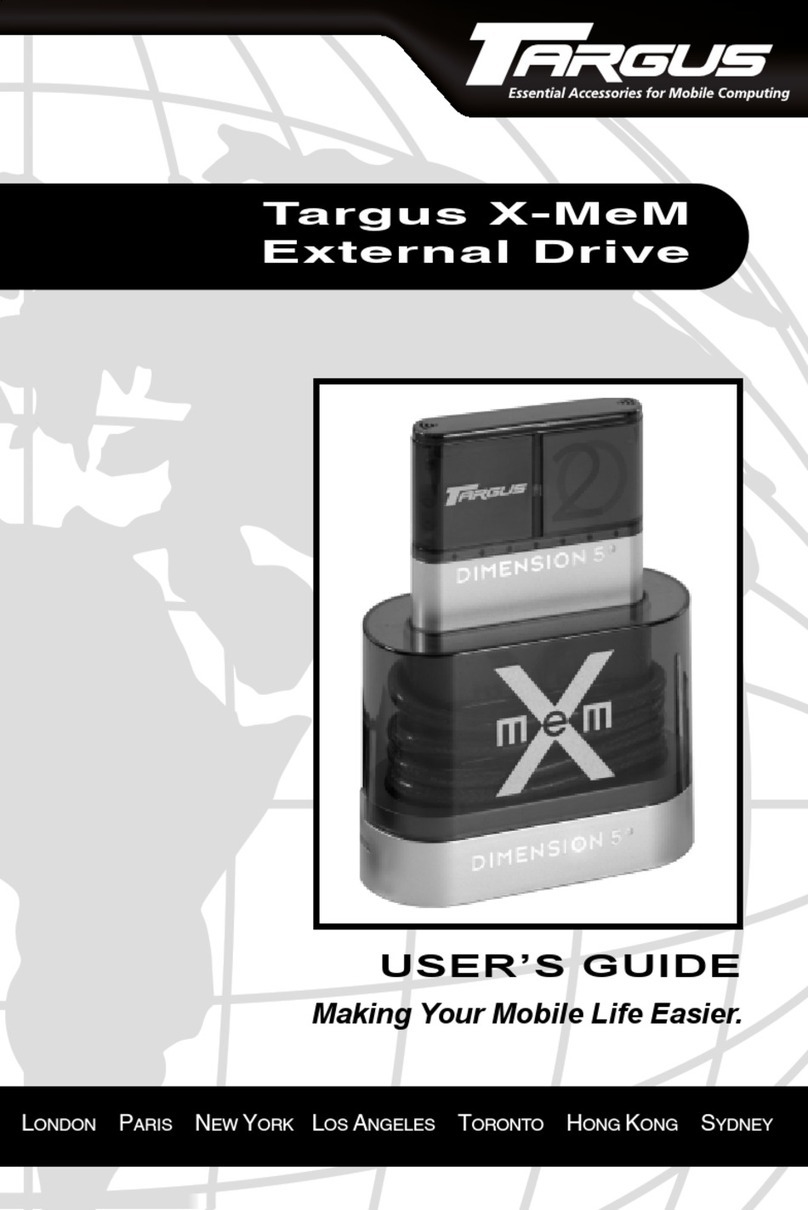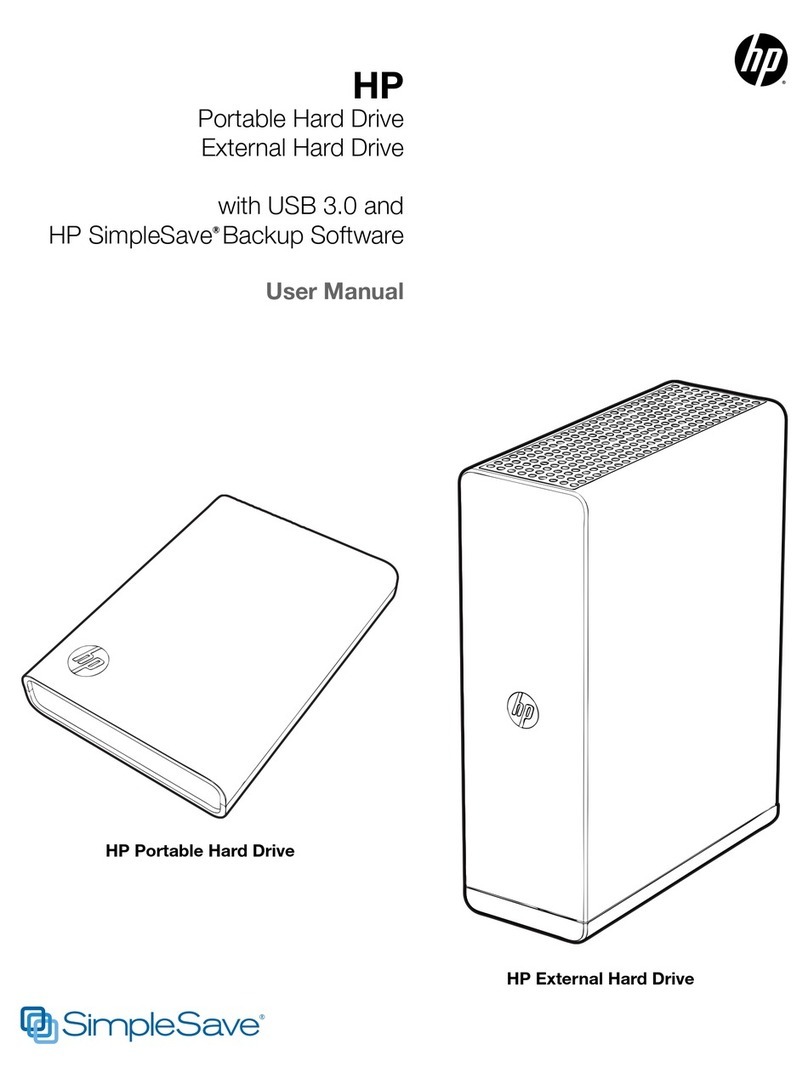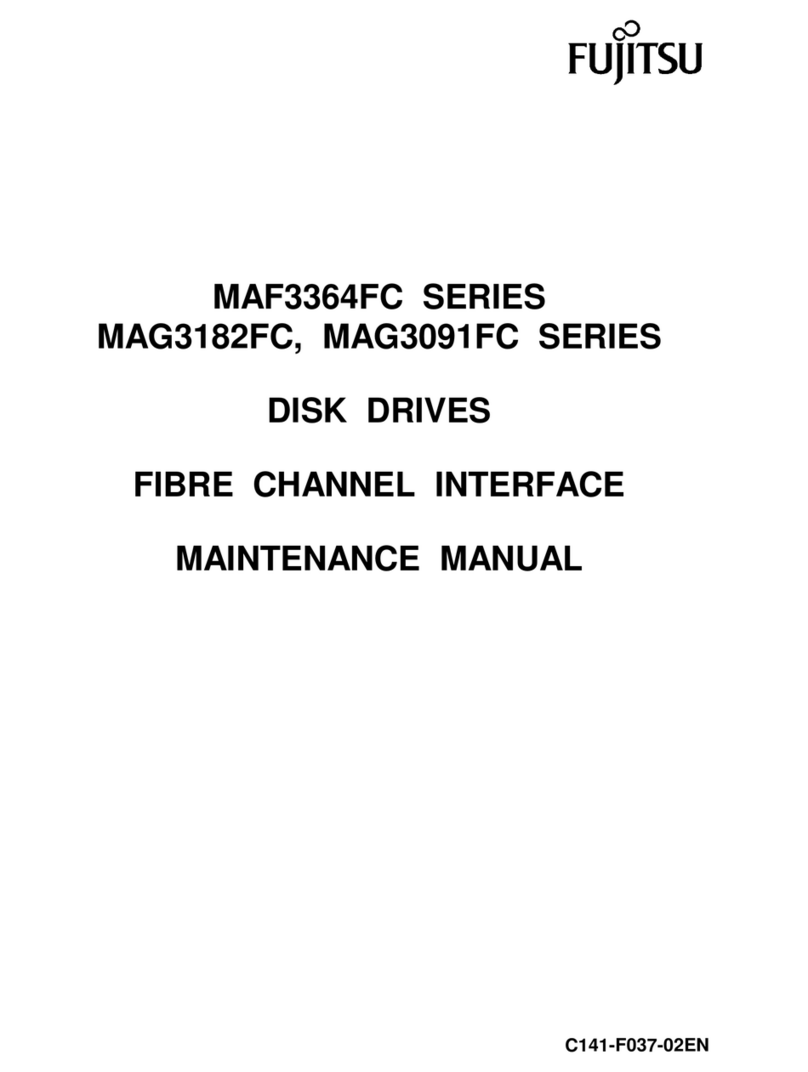Smacq Technologies USB-5200 Series User manual

USB-5200 Series Multifunctional
Data Acquisition Devices
User Manual
Rev. C
Beijing Smacq Technology Co., Ltd.
Smacq.com
Smacq.cn
竺
macq.
Smacq

Statement
Copyright
©2018 Beijing Smacq Technology Co., Ltd. All rights reserved
No content of this manual may be reproduced, modified or abridged without prior
consent and written permission.
Trademark information
Smacq is a registered trademark of Beijing Smacq Technology Co., Ltd The
names of the other products and companies mentioned in this document are
trademarks or trade names of their respective companies.
Other Disclaimer
1 |
Contact Us
If you have any questions or need assistance in using this product or this
document, please contact us via:
Phone:(+86)10-52482802
E-Mail: [email protected]
Website: http://www.smacq.com
http://www.smacq.cn
The information provided in this document may be modified and updated in
subsequent versions without prior notice.
Smacq does not provide any warranties, express or implied, for this document
as well as the information inside it, including but not limited to implied
warranties of the marketable nature of the product and its suitability for a
particular purpose.
There may be a chance that inaccurate descriptions or errors exist in this
document. Smacq does not hold any liability for accidents because of the
information and deductive functions provided in this manual, as well as the
resulting loss of any chance because of the use of this document.
Smacq reserves the rights to change product specifications, prices, and decide
whether to stop the production.

2 |
Safety Requirements
Warning
Warning
Warning
Warning
Warning
Warning
Only the voltage within the specified range can be connected.
Voltage exceeding the specified range may cause damage to the
device, and even present a negative impact on personal safety.
Check the product specification for detailed reference to the range
of voltages that can be connected by each port.
Do not attempt to operate the device in other ways that are not
mentioned in this document. Incorrect use of the device may be
dangerous. In the event of device damage, the internal security
protection mechanism will also be affected.
Do not attempt to replace device components or change devices
in other ways that are not mentioned in this document. Do not
repair the device yourself in the event of a product failure.
Do not use the device in an environment where an explosion may
occur or where flammable flue or gas is present. If you must use
the device in this kind of environment, please fit it into a proper
case.
While the device is running, all chassis covers and fill panels need
to be closed.
For equipment with exhaust vents, do not insert foreign objects
into the vents or block air circulation in the vents.

3 |
Measurement Categories
Warning For use in measurement category I (CAT I) only. Do not use in
measurement category II/III/IV. Use this device to connect
signals or make measurements.
Measurement categories Note
Measurement categories I (CAT I) means that measurements are made on a circuit that
is not directly connected to the main power supply. For example, a circuit that is not
exported from the main power supply, especially a circuit that is exported from a
protected (internal) primary power supply, is measured. In the latter case, the
instantaneous stress will change. Therefore, the user should be aware of the
instantaneous affordability of the device.
Measurement categories II (CAT II) means that measurements are made on a circuit
that is directly connected to a low-voltage device. For example, a measurement on
household appliances, portable tools and similar equipment.
Measurement categories III (CAT III) means that measurements are made in
construction equipment. For example, a measurement on the distribution boards, circuit
breakers, wiring (including cables, Busbars, junction boxes, switches, sockets) in fixed
equipment and equipment for industrial use and certain other equipment (for example,
fixed motors that are permanently connected to fixtures).
Measurement categories IV (CAT IV) means that measurements are made on the source
of low-voltage equipment. For example, a measurement on a meter, a major overcurrent
protection device, and a pulse control unit.
Environment
Temperature
Operating 0℃~ 55℃
Storage -40℃~ 85℃
Humidity
Operating 5%RH ~ 95%RH, no condensation
Storage 5%RH ~ 95%RH, no condensation
Pollution degree 2
Highest elevation 2000 m

4 |
Some of the substances contained in this product may be harmful
to the environment or human health. In order to avoid releasing
harmful substances into the environment or endangering human
health, it is recommended that appropriate methods be used to
recover this product to ensure that most materials can be properly
reused or recycled. For information about processing or recycling,
please contact your local professional organizations.
Pollution degree description
Pollution degree 1: No pollution, or only dry non-conductive pollution. This pollution
degree has no effect. For example: a clean room or an air-conditioned office
environment.
Pollution degree 2: Generally only dry non-conductive pollution occurs. Temporary
conduction can sometimes occur due to condensation. For example: General indoor
environment.
Pollution degree 3: Conductive pollution occurs, or dry non-conductive pollution becomes
conductive due to condensation. For example, an outdoor sheltered environment.
Pollution degree 4: Permanent conductive pollution caused by conductive dust, rain, or
snow. For example: Outdoor places.
Recycle precautions
Warning

5 |
CONTENT
STATEMENT.............................................................................................................. 1
SAFETY REQUIREMENTS........................................................................................... 2
MEASUREMENT CATEGORIES................................................................................... 3
ENVIRONMENT......................................................................................................... 3
1. GETTING STARTED............................................................................................. 7
1.1. PRODUCT INTRODUCTION..................................................................................7
1.2. FUNCTION DIAGRAM..........................................................................................8
1.3. PRODUCT SPECIFICATIONS................................................................................8
1.4. PRODUCT UNPACKING.......................................................................................11
PRECAUTIONS..........................................................................................................11
CHECK THE PACKING LIST........................................................................................11
2. INSTALLATION................................................................................................. 12
2.1. CONNECTOR SIGNAL PINS DISTRIBUTION.........................................................12
2.2. USB CABLE REINFORCEMENT DESIGN................................................................13
2.3. DRIVER INSTALLATION.....................................................................................14
3. ANALOG INPUT (AI)..........................................................................................15
3.1. CIRCUIT DIAGRAM.............................................................................................16
3.2. SIGNAL CONNECTION METHODS........................................................................16
3.3. SIGNAL ACQUISITION MODE.............................................................................16
HARDWARE TIMING MODE.......................................................................................16
CONTINUOUS ACQUISITION MODE.......................................................................... 16
LIMITED NUMBER ACQUISITION MODE.................................................................... 17
AI SAMPLING CLOCK..........................................................................................17
3.5. TRIGGER.......................................................................................................... 18
CLEAR TRIGGER.......................................................................................................18
PRE-TRIGGER...........................................................................................................18
4. DIGITAL INPUT (DI)...........................................................................................20
4.1. SIGNAL ACQUISITION MODE............................................................................. 20
HARDWARE TIMING................................................................................................. 20
CONTINUOUS ACQUISITION MODE........................................................................... 20
LIMITED NUMBER ACQUISITION MODE.....................................................................20
4.2. SAMPLING RATE................................................................................................21
4.3. DI SAMPLING CLOCK..........................................................................................21
4.4. TRIGGER...........................................................................................................21
CLEAR TRIGGER .......................................................................................................22
PRE-TRIGGER..........................................................................................................22
5. DIGITAL OUTPUT (DO).................................................................................... 24
5.1. SIGNAL OUTPUT MODE......................................................................................24
3.4.

6 |
IMMEDIATE OUTPUT................................................................................................ 24
HARDWARE TIMING................................................................................................. 24
FINITE NUMBER OUTPUT MODE ............................................................................... 24
INFINITE LOOP OUTPUT MODE................................................................................. 25
INFINITE NON-LOOP OUTPUT MODE........................................................................ 25
5.2. OUTPUT UPDATE RATE..................................................................................... 25
5.3. DO SAMPLING CLOCK........................................................................................ 25
5.4. TRIGGER.......................................................................................................... 26
CLEAR TRIGGER ....................................................................................................... 27
6. SYNCHRONIZATION SYSTEM............................................................................ 28
6.1. SAMPLING CLOCK ............................................................................................. 28
6.2. EXTERNAL TRIGGER.......................................................................................... 28
7. SERVICE AND WARRANTY.................................................................................30
8. ORDERING INFORMATION................................................................................31

7 |
1. Getting Started
This chapter describes the basic functions of USB-5200 Series Data Acquisition Device,
as well as product specifications and precautions in the process of product unpacking.
1.1. Product introduction
USB-5200 Series data acquisition device is the multifunctional data acquisition device based
on high-speed USB2.0 interface. When connected to the computer, it can be used for
continuous high-speed signal acquisition and high-speed control signal output.
USB-5200 series of data acquisition devices can measure analog and digital signals
continuously and save the data to the computer hard drive without interruption. It can also
provide digital signal output, periodic repetitive signal output, and high-speed
uninterrupted non-repetitive signal output controlled by a computer.
USB-5200 series data acquisition device supports operating in Windows OS, providing
standard DLLs and support for mainstream development languages including VC++, VB, C#,
LabVIEW, and MATLAB.
USB-5200 series data acquisition device provides multiple models, in terms of function and
performance. For detailed reference, please turn to Chapter 1.3 for specification
description of each model.
Key Features
High speed USB interface, Plug and Play, USB powered
16-bit analog input resolution, support continuous uninterrupted acquisition
The analog input supports up to 16 channels of synchronous sampling and up
to 500kS/s/Ch sampling rate.
Up to 10MS/s/Ch sampling rate for digital I/O

8 |
1.2. Function Diagram
Figure 1.1 shows the schematic diagram of USB-5200 series data acquisition device.
Digital system
USB bus
Trigger source:
Software trigger
External trigger
Din trigger
Sampling clock source:
Internal module sampling
clock source
External sampling clock
source
AI
Digital I/O
FIFI cache
Figure 1.1 USB-5200 series data acquisition device functions
1.3. Product specifications
The following product specification parameters, unless otherwise stated, are acquired at
the temperature of 25°C and the humidity of 40%, while the device is turned on for 20
minutes.
Analog input
Number of channels
USB-5220/5221: 16Single-Ended
USB-5210/5211: 8Single-Ended
USB-5620/5621: 16Single-Ended
USB-5610/5611: 8Single-Ended
USB-5420/5421: 8Single-Ended
USB-5410/5411: 8Single-Ended
ADC type SAR
Resolution USB-5220/5221/5210/5211: 16-bit
USB-5620/5621/5610/5611: 14-bit

9 |
USB-5420/5421/5410/5411:12-bit
Highest sampling rate
USB-5211/5221: 500
USB-5210/5220: 250
USB-5611/5621: 500
USB-5610/5620: 250
USB-5411/5421: 500
kS/s/Ch,continuous
kS/s/Ch,continuous
kS/s/Ch,continuous
kS/s/Ch,continuous
kS/s/Ch,continuous
USB-5410/5420: 250kS/s/Ch,continuous
Timing resolution 10ns
Channel synchronization Yes
Range ±10 V / ±5V
Input coupling mode DC
Input impedance 100 MΩ
Small signal bandwidth
(-3 dB)
Input bias current 1uA
Analog input
max voltage ±1 5 V
Software FIFO 2 MPts/Ch
Pre-trigger FIFO 4096 Pts
AI capture mode Continuous acquisition mode and limited number acquisition mode
Analog input accuracy (with temperature coefficient of 5 ppm/℃)
Range Gain error
(ppm of reading)
Offset error
(ppm of range)
Random noise
(μVrms)
Full range
absolute accuracy
(μV)
±10 V90 4180 1100
±5 V80 10 90 500
Digital I/O
Number of channels USB-5210/5211/5610/5611/5410/5411: 8 input,8 output
USB-5220/5221/5620/5621/5420/5421: 2 input,2 output
Ground reference DGND
10 kΩ
Digital input pull-up
resistanc
Digital input voltage High level:1.95 V~5 V
Low level:0 V~1.2 V
Digital output voltage High level:3.3 V
Low level:0 V~0.003 V
Low level
Digital output
power-on status
10 MS/s/Ch
450 kHz
DIN highest
sampling rate

10 |
DOUT highest
update rate 10 MS/s/Ch
Timing resolution 10 ns
Channel synchronization Yes
DIN software FIFO 2 MPts/Ch
DIN pre-trigger FIFO 2048 Pts/Ch
DOUT hardware FIFO 2048 Pts/Ch
DIN capture mode Continuous acquisition mode and OneShot mode
DOUT output mode
Direct output; onboard FIFO waveform periodic
generation; onboard FIFO waveform trigger N loop;
Uninterrupted non-repetitive signals for computer caches
DOUT edge time Ascending edge: 6 ns
Descending edge: 8 ns
External trigger
Number of channels 1 input, 1 output
Input voltage High level: 1.95 V~5 V
Low level: 0 V~1.2 V
Output voltage High level: 3.3 V
Low level: 0 V~0.003 V
Output power-on status Low level
Output edge time Ascending edge: 6 ns
Descending edge: 8 ns
External sampling clock I/O
Number of channels 1 input、1 output
Input voltage High level:1.95 V~5 V
Low level:0 V~1.2 V
Output voltage High level: 3.3 V
Low level:0 V~0.003 V
Low level
Output power-on
status
DC~1 MHz
Output edge time Ascending edge: 6 ns
Descending edge: 8 ns
Calibration
No less than 20Minutes
Recommended
warm-up time
1 year
Output frequency
range
Recommended
calibration interval

11 |
Bus interface
USB USB2.0 High Speed interface
Power supply requirements
4.5 V~5.5 V
USB interface
power supply
420 mA
Maximum Load 600mA
Physical properties
Size (mm) Without connectors: 150*96*28
Connectors included: 150*112*28
Weight (g) Without connectors: about 185g
Connectors included: about 230g
I/O connectors Bolt terminals
Bolt terminal
connection 16 AWG~28 AWG
USB connectors USB Type B
1.4. Product unpacking
Precautions
To prevent electrostatic discharge (ESD) from damaging the device, please note the
following:
Check the packing list
After unpacking the product, follow the packing list in the box, check the host and each
attachment individually to ensure that the items in the box are consistent with the
packing list.
If you find that any item is missing, please get in touch with us for help as soon as
possible.
If you find that the product comes in damaged after unpacking, please get in touch with
us as soon as possible. Do not install damaged equipment on your devices.
Typical current
without load
Please wear a grounding wristband or touch a grounded object first to
ensure being grounded.
Before removing the equipment from the packaging, please first connect
the anti-static packaging to the grounded object.
Do not touch the exposed pins of the connector.
Place your device in anti-static packaging when you are not using the device.

12 |
2. Installation
This chapter describes signal connection and drive installation of USB-5200 series data
acquisition device.
2.1. Connector signal pins distribution
Figure 2.1 USB-5200 signal pins distribution
Table 2.1, Signal pin allocation
Signal name Notes
AI 0
Analog input 0
AI 1
Analog input 1
AI 2
Analog input 2

13 |
Signal name Notes
AI 3 Analog input 3
AI 4 Analog input 4
AI 5 Analog input 5
AI 6 Analog input 6
AI 7 Analog input 7
AI 8 Analog input 8
AI 9 Analog input 9
AI 10 Analog input 10
AI 11 Analog input 11
AI 12 Analog input 12
AI 13 Analog input 13
AI 14 Analog input 14
AI 15 Analog input 15
AGND Simulated ground
DI 0 Digital input 0
DI 1 Digital input1
DO 0 Digital output 0
DO 1 Digital output1
DGND Digital ground
EXT TRIG OUT
EXT TRIG IN
CONV OUT
CONV IN
Trigger signal output
External trigger signal input
Sampling clock output
External sampling clock input
2.2. USB cable reinforcement design
USB cable connectors are prone to be pulled off during operation. USB-5200 series
data acquisition devices provide a cable reinforcement design, with which a strap can
be used to fix the USB cable to the device to prevent the accidents. Check Figure 2.2
for details.

14 |
Figure 2.2 USB cable reinforcement design
2.3. Drive installation
Smacq USB-5200 series data acquisition device support Microsoft Windows XP, Windows 7,
Windows 8/8.1, and Windows 10, including all the 32-bit and 64-bit versions. To install
the driver for USB-5200 devices, you need to turn off driver signature enforcement first.
Here is an example step-by-step tutorial on how to install the driver in Windows 7.
1) Connect your USB-5200 card to the computer and launch the Device Manager in
Windows.
2) There should be a device with an exclamation point.”
Right-click it, select “Update driver”.
3) In the pop-up dialog box, select “Browse my computer for driver software”
4) And then select “Let me pick from a list of device drivers on my computer”
5) Click on “Next” and then select “Have disk”
6) Click Browse in the pop-up dialog box, then enter the \USB-3000SeriesDAQ\driver
folder in the CD-ROM, then enter the "win7" folder, then the 32-bit operating
system enters the "x86" folder, the 64-bit operating system enters the "x64"
folder, select the "susb.inf" file, and then click "Open". (The drivers of
Windows8/8.1 and Windows10 are the same as those of Windows7, using the
same file. )
7) Then in the dialogue of “Install from disk”, click on “Yes”.

15 |
8) Click “Next”, if the Windows security warning pops up, you need to select “Install
this driver software anyway” to finish the installation.
After these steps, the operating system will start installing the driver, which usually takes
about 30 seconds. After the driver is installed, the exclamation point in Device Manager
will disappear, as shown in the following Figure 2.3.
Figure 2.3 the Device Manager after the driver is correctly installed
3. Analog Input(AI)
This chapter describes measuring the relevant content of analog input signals on
USB-5200 series data acquisition devices. AI here is short for Analog Input.

16 |
3.1. Circuit diagram
Ai 0 ADCPGA
ADCPGA
ADCPGA
…………
Ai 1
Ai 2
Ai n
Figure 3.1 analog input circuit
3.2. Signal Connection Mode
When the USB-5200 series data acquisition device performs analog input measurement,
it supports continuous acquisition mode or limited number acquisition mode. The
sampling rates of both modes are hardware-timed. The limited number acquisition
mode is called OneShot mode.
Hardware timing mode
Hardware timing means that the sampling rate of AI acquisition is controlled by a
hardware digital signal (AI sampling clock), which can be generated internally or
externally.
Please refer to the chapter of “Synchronization system” for detailed settings for using
externally provided sampling clocks.
Continuous acquisition mode
Continuous acquisition mode refers to continuous and uninterrupted collection of data at
defined sampling speed.
The AI acquisition connection mode of the USB-5200 series data acquisition device
supports grounding reference single-ended input. The positive end of the analog input
signal is connected to the Ain port of the analog input port, and the negative end of
the input signal is linked to the AGND port.
3.3. Signal acquisition mode
PGA ADC

17 |
In continuous acquisition mode, after the AI acquisition is triggered, the acquisition
device collects the signal at a fixed sampling speed, buffers data into FIFO, and
continuously uploads the data in the FIFO to the computer memory buffer. The user
program only needs to continuously process the data in memory to achieve continuous
uninterrupted data acquisition.
If the user program does not process the data fast enough, the data will gradually fill the
2M points of storage space in computer memory buffer. New data cannot be written
correctly after the memory is filled up, resulting in discontinuous data.
Limited number acquisition mode
Limited number acquisition mode (OneShot mode) refers to one time acquisition to get
the set number of collection points at the set sampling speed.
In OneShot mode, after the AI acquisition triggers, the acquisition device automatically
stops the acquisition after the acquisition reaches the set number of times according to
the set sampling speed. The user program only needs to read the set data amount from
the computer memory buffer.
Attention The set number of collection points cannot exceed 2MPts.
3.4. AI sampling clock
The USB-5200 series data acquisition device has a rich collection timing option.
The schematic diagram of the AI sampling clock is shown in Figure 3.2.
AI timer
DI timer
DO timer
Conv_IN external sampling
AI sampling clock
Figure 3.2 AI sampling clock options
The AI acquisition uses the AI timer signal as the AI sampling clock by default. The AI
acquisition can be set via software to use other sampling clock sources to achieve the
synchronization of each function.
All timers can be set in steps of 10ns, but the set sampling rate cannot exceed the
maximum sampling rate supported by the device.
The external sampling clock source input from Conv_IN cannot be set to divide or
multiply. It can only be used directly as the sampling clock. The AI timer output signal
can be set to the Conv_OUT pin via software for simultaneous synchronization of
multiple devices. See the "Synchronization System" chapter for details on the external
clock.

18 |
3.5. Trigger
The USB-5200 series data acquisition device provides rich trigger options. The
schematic diagram of the AI acquisition trigger options are shown in Figure 3.3.
AiSoftTrig software trigger
GlobalSoftTrig global software trigger
Ext_Trig_IN external trigger input
Din_0 edge trigger
Din_1 edge trigger
DI acquisition trigger
DO acquisition trigger
AI trigger signal
Figure 3.3 AI trigger options
The AI acquisition uses the AiSoftTrig software trigger as the trigger source by default.
The AI acquisition can use other trigger sources via software settings to achieve the
synchronization of each function.
AiSoftTrig software trigger and GlobalSoftTrig global software trigger are software
triggers, which are used to send a command to the acquisition device to initiate device
triggering.
Ext_Trig_IN external trigger means that when Ext_Trig_IN receives a rising edge,
the device triggers. The AI trigger signal can be set to the Ext_Trig_OUT pin via
software for multiple device synchronization. See the "Synchronization System" chapter
for details on the external trigger.
The Din_0 ~ Din_1 edge trigger means that when the DIO is configured as an input, the
DIO pin receives a rising edge and the device triggers.
DI acquisition trigger and DO acquisition trigger can be used to trigger the AI function
alongside their own functions to achieve the synchronization of each function.
Clear trigger
The AI trigger status can be reset to an untriggered state by software settings.
Pre-trigger
The pre-trigger function is used to record the pre-trigger signal. The pre-trigger function
relies on the hardware FIFO to store the data of the pre-trigger signal, so the number of
pre-triggered points is limited and cannot exceed 4kPts. The pre-trigger function diagram
is shown in Figure 3.4.

19 |
Figure 3.4 AI pre-trigger function
When the pre-trigger point is set to 0, the data before the trigger signal is not stored,
and the user will not be able to obtain the signal state before the trigger signal.
When the pre-trigger signal is set to be larger than 0, for example, in Figure 3.4, the
number of pre-trigger points is set to 3, then the data before the trigger signal will be
stored, and when the stored quantity reaches 3, the newly acquired data will
automatically remove the oldest data in the FIFO to ensure that the latest 3 data is
saved in the FIFO before the trigger.
This manual suits for next models
12
Table of contents
Other Smacq Technologies Storage manuals
Popular Storage manuals by other brands
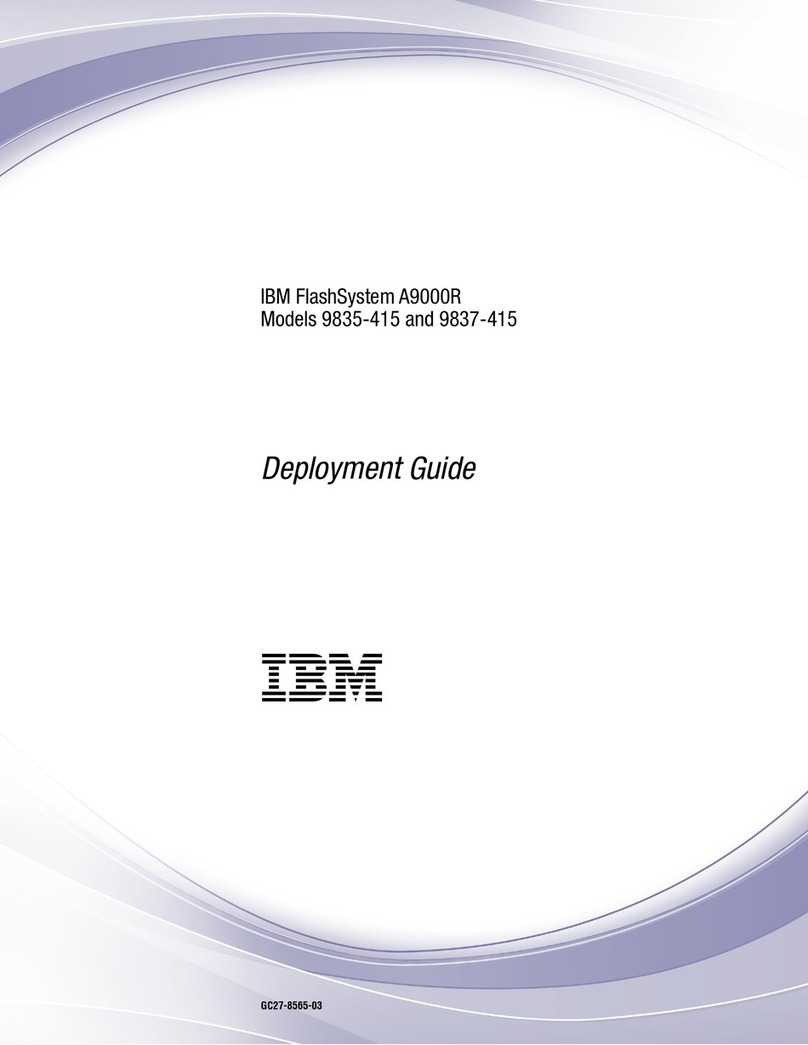
IBM
IBM FlashSystem A9000R Deployment guide

Hama
Hama PROTECTIONKEY operating instructions

FourStarGroup
FourStarGroup 11223989V quick start guide

Overland Tandberg
Overland Tandberg NEOxl 80 Replacement instructions

HP
HP StorageWorks 4000/6000/8000 - Enterprise Virtual... release note
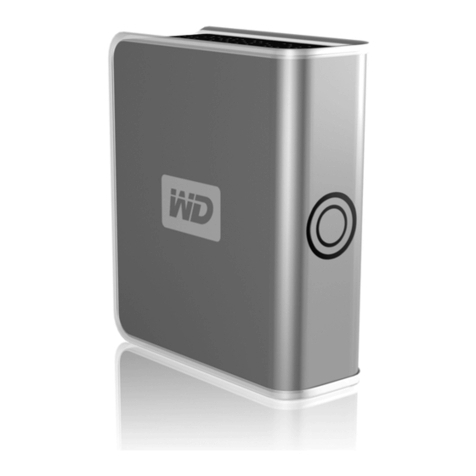
Western Digital
Western Digital My Book Pro Quick install guide
